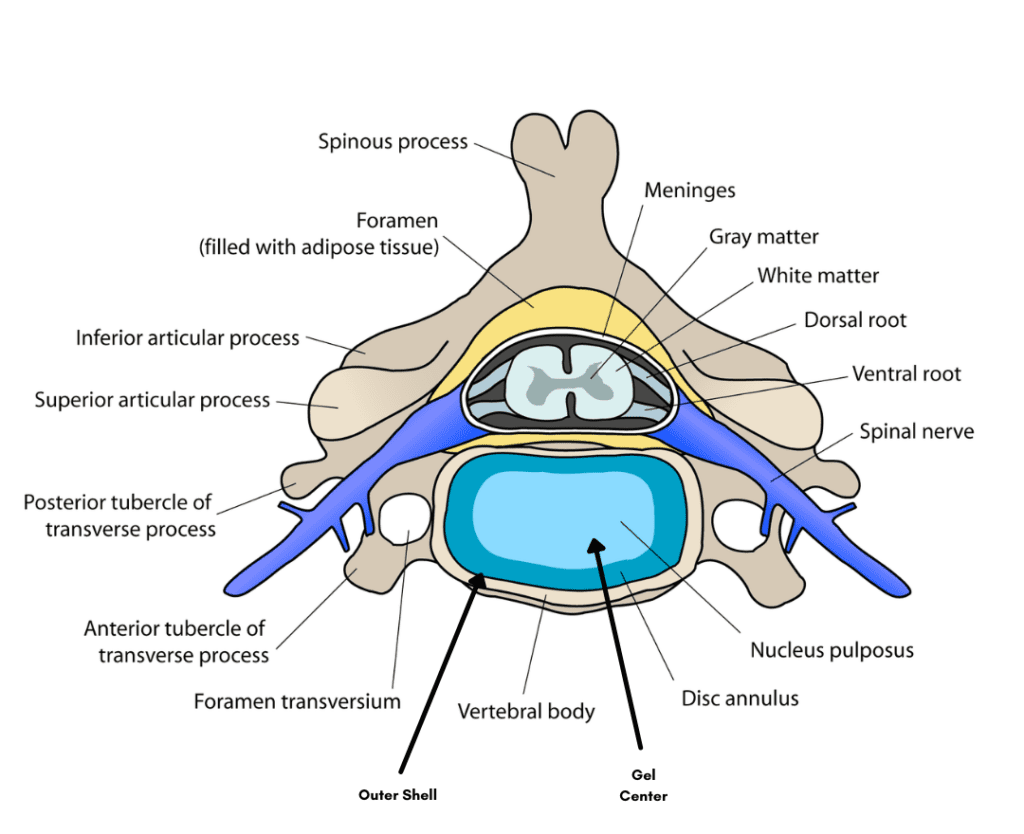Cervical disc bulges can be a very painful condition. However, this condition can resolve very quickly with the proper at-home care. In this post, I'm going to give some tips for at-home care that can help a cervical disc bulge get better very quickly. If you know that you're dealing with a cervical disc bulge, follow these instructions - and you could be pain-free in no time.
The first part of managing a cervical disc bulge is to understand what's going on. The discs in our spine are similar to a jelly donut. There is a hard outer shell with a gel center. This allows our discs to act as a cushion for the forces that go through our spine; they act as shock absorbers. Without our discs' protection, anytime we fell down, or had a hard bump into something, we would be at risk of compression fractures in our spine. Our discs help to absorb the force of these various blows, and they keep that force from being focused into the bones of our spine.

The structure of the disc actually moves with our spine. The gel and the center of the disc is called the nucleus pulposus. Whenever we bend our spine forward, that gel is pushed to the back of the disc and whenever we bend our spine backwards, the gel moves to the front of the disc.

If you think about it for a minute, you can see that most of our daily habits - things like computer usage, usage of cell phones and tablets, reading, and many others - cause our Cervical spine to bend forward. Very few of our common daily habits bend our Cervical spine backwards. Due to this mismatch in movement of our spine, the gel in the center of many of our discs, over time, can start to migrate towards the back of the disc. This eventually starts to put pressure on the outer shell of the disc in the back.
Eventually, this will start to weaken the outer shell and can lead to a bulge in the back of the shell. When this happens in our neck, it's referred to as a cervical disc bulge. This can cause pain and irritation in the neck and tightness in the muscles of the neck.
The other symptom that can be very painful when experiencing a cervical disc bulge is pain in the nerves that go into our arm. When the disc starts to bulge in the back, it can come into contact with the nerves that exit our neck, leading into our arms. This bulging can lead to pain, numbness, tingling, burning, and weakness in the arm.
The proper home care will often allow Cervical Neck Bulges to get better very quickly. Below, I'm listing the best tips for things to do at home that can help you feel better as quickly as possible.
The nerves in our neck react to inflammation differently than the nerves in our low back. The discs in our neck are prone towards excessive inflammation. Scientists have shown in research studies that the nerves in our neck can swell up to twice their normal size when in the presence of inflammation. This can make them twice as likely to get pressed on during a cervical disc bulge.
I often explain disc injuries to my patients as being similar to getting a cut on your knuckle. If you have a cut on your knuckle and you continually bend your finger all day long, the scab gets ripped open multiple times a day - clearly, it will take longer to heal.
A similar effect happens with disc injuries. Since bending our spine forward pushes the gel to the back -- then, every time you bend your spine forward while you have an irritated disc, that bending will cause the disc to become further irritated. This can lead to a constant cycle of pain.
So - when you have a Cervical Disc Bulge, after you've taken actions to STOP the Inflammation, the next tip for you is to limit how often you bend your neck forward (this stops "the scab" from reopening).
This tip alone can be a miracle that helps decrease/eliminate pain during a cervical disc bulge.
Once you quit "picking the scab" each day, you'll notice the pain start to get better very quickly. The next step is to start to move the gel in the disc back to the center.
To do this, we have to use the motion of our spine to accomplish it. As I mentioned above, bending our spine forward too much moves the gel to the back. So in order to move the gel forward to the center, we have to bend our spine backwards often.
To do this, we use an exercise called a chin retraction. In the video above, you'll see this exercise demonstrated. You need to sit up tall and pull your chin backwards like you're giving yourself a double chin. Once you've moved your chin back as far as you can using the muscles of your neck, you will use two fingers on your chin to push your spine backwards even more. If you are having nerve pain going down into the arms, you want to make sure that you use two fingers of the arm that is not painful when you do this exercise.
When you do this action, the gel in the disc gets pushed to the back -- finally, after many years of bending our spine forward more than we've been bending it backwards. So in order to effectively reposition that gel correctly now, we have to bend our spine backwards a lot. At the beginning of a cervical disc bulge, you will want to do 10 of these chin retractions every two hours that you're awake.
The final tip is to get the pressure off the nerves.*
*This tip should only be used if you're having nerve symptoms in one of your arms. When the disc presses on your nerves, it can change the way your nerves move in your arm when you're doing daily tasks.
There are usually three main nerves that can be affected when we have arm pain during a cervical disc bulge. These are the median nerve, the radial nerve, and the ulnar nerve. In order to improve how these nerves move, you would use the exercises shown below.
Each of these three nerves supplies different parts of your arm with sensation.
Note: You would want to do the exercises 1 to 2 times a day and do 10 repetitions each time. These exercises can greatly diminish the symptoms in the arm especially when paired with the chin retractions.
So there you have it! Cervical disc bulges can create a very painful and debilitating condition.
But they can also resolve very quickly if managed correctly. If you know you are dealing with a cervical disc bulge, try these tips and you may likely find that your pain gets better very rapidly!
If you try these tips and are still in pain, your best course of action is to get treatment.
We treat these conditions every day at Movement Laboratory and are very successful at resolving this injury without surgery. Give us a call at 918-300-4084 and schedule an appointment today to let us help you with your cervical disc bulge!
By: John H. Keefe IV, D.C.
